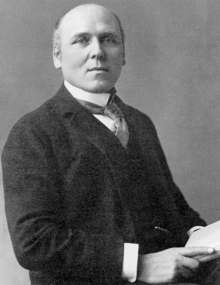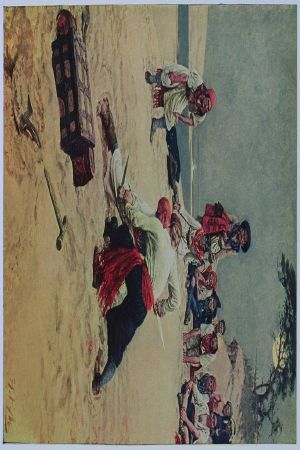Difference between revisions of "Howard Pyle" - New World Encyclopedia
| Line 22: | Line 22: | ||
}} | }} | ||
[[Image:Sir Kay breaketh his sword.jpg|thumb|"[[Sir Kay]] breaketh his sword at ye Tournament", one of Pyle's [[Arthurian]] illustrations.]] | [[Image:Sir Kay breaketh his sword.jpg|thumb|"[[Sir Kay]] breaketh his sword at ye Tournament", one of Pyle's [[Arthurian]] illustrations.]] | ||
| − | '''Howard Pyle''' ( | + | '''Howard Pyle''' (March 5, 1853 – November 9, 1911) was an influential [[United States|American]] [[illustrator]] and writer, primarily of books for young audiences. A native of [[Wilmington, Delaware|Wilmington]], [[Delaware]], he opened an art school in his hometown where he taught another renowned artist and illustrator, his protogee, [[N. C. Wyeth]]. During the [[Golden Age of Illustration]] both artists brought the printed word to life through their vivid descriptions of [[piracy|pirates]], fair maidens and other [[medieval]] characters, like the legendary [[Robin Hood]]. |
| + | Pyle was also a prolific writer who authored and illustrated over 24 books including ''The Story of King Arthur and His Knights.'' While he did not focus on historical accuracy, his works did reflect the love of adventure that was so popular at the turn of the century before the advent of [[film industry (United States)|movies]], and [[television]]. | ||
==Biography== | ==Biography== | ||
| + | Howard Pyle was born in Wilmington, Delaware in 1853, the same year as [[Vincent Van Gogh]]. In the 1870s Pyle had a short stint at the Art Students League in [[New York City]]. Many of his early illustrations appeared in magazines such as [[Harper's Weekly]] and [[Colliers]]. In 1880 he returned to Wilmington, Delaware, already an established illustrator. | ||
| + | As one critic said of Pyle, "His rapid rise to popularity was due to his remarkable gift for seizing and expresing the dramatic gist of a story.''<ref>*[http://www.delart.org/]</ref> | ||
| + | |||
| + | |||
In 1894 he began teaching illustration at the Drexel Institute of Art, Science and Industry (now [[Drexel University]]), and after 1900 he founded his own school of art and illustration (later called the [[Brandywine School]]). Some of his more famous students were [[Olive Rush]], [[N. C. Wyeth]], [[Maxfield Parrish]], [[Frank Schoonover]], and [[Jessie Willcox Smith]]. | In 1894 he began teaching illustration at the Drexel Institute of Art, Science and Industry (now [[Drexel University]]), and after 1900 he founded his own school of art and illustration (later called the [[Brandywine School]]). Some of his more famous students were [[Olive Rush]], [[N. C. Wyeth]], [[Maxfield Parrish]], [[Frank Schoonover]], and [[Jessie Willcox Smith]]. | ||
His 1883 classic ''[[The Merry Adventures of Robin Hood]]'' remains in print to this day, and his other books, frequently with medieval European settings, include a four-volume set on [[King Arthur]] that cemented his reputation. | His 1883 classic ''[[The Merry Adventures of Robin Hood]]'' remains in print to this day, and his other books, frequently with medieval European settings, include a four-volume set on [[King Arthur]] that cemented his reputation. | ||
| − | + | He also illustrated historical and adventure stories for periodicals such as ''[[Harper's Weekly]]'' and ''[[St. Nicholas Magazine]]''. His ''[[Men of Iron]]'' was made into a movie in 1954, ''[[The Black Shield of Falworth]]''. | |
Pyle travelled to Florence, Italy to study mural painting in 1910, and died there in 1911 of sudden kidney infection. | Pyle travelled to Florence, Italy to study mural painting in 1910, and died there in 1911 of sudden kidney infection. | ||
| − | |||
| − | |||
==Major works== | ==Major works== | ||
Revision as of 20:37, 3 November 2007
| Howard Pyle | |
 | |
| Born | March 5 1853 Wilmington, Delaware, United States |
| Died | November 9 1911 (aged 58) Florence, Italy |
| Nationality | American |
Howard Pyle (March 5, 1853 – November 9, 1911) was an influential American illustrator and writer, primarily of books for young audiences. A native of Wilmington, Delaware, he opened an art school in his hometown where he taught another renowned artist and illustrator, his protogee, N. C. Wyeth. During the Golden Age of Illustration both artists brought the printed word to life through their vivid descriptions of pirates, fair maidens and other medieval characters, like the legendary Robin Hood.
Pyle was also a prolific writer who authored and illustrated over 24 books including The Story of King Arthur and His Knights. While he did not focus on historical accuracy, his works did reflect the love of adventure that was so popular at the turn of the century before the advent of movies, and television.
Biography
Howard Pyle was born in Wilmington, Delaware in 1853, the same year as Vincent Van Gogh. In the 1870s Pyle had a short stint at the Art Students League in New York City. Many of his early illustrations appeared in magazines such as Harper's Weekly and Colliers. In 1880 he returned to Wilmington, Delaware, already an established illustrator. As one critic said of Pyle, "His rapid rise to popularity was due to his remarkable gift for seizing and expresing the dramatic gist of a story.[1]
In 1894 he began teaching illustration at the Drexel Institute of Art, Science and Industry (now Drexel University), and after 1900 he founded his own school of art and illustration (later called the Brandywine School). Some of his more famous students were Olive Rush, N. C. Wyeth, Maxfield Parrish, Frank Schoonover, and Jessie Willcox Smith.
His 1883 classic The Merry Adventures of Robin Hood remains in print to this day, and his other books, frequently with medieval European settings, include a four-volume set on King Arthur that cemented his reputation.
He also illustrated historical and adventure stories for periodicals such as Harper's Weekly and St. Nicholas Magazine. His Men of Iron was made into a movie in 1954, The Black Shield of Falworth.
Pyle travelled to Florence, Italy to study mural painting in 1910, and died there in 1911 of sudden kidney infection.
Major works

In addition to numerous illustrations for Harper's Weekly, other periodical publications, and the children's books of others, Pyle wrote and illustrated a number of books himself.
The Merry Adventures of Robin Hood is Pyle's distillation of many Robin Hood legends and ballads, modified to make them suitable for the child audience he sought to appeal to. He modified the ballad "Robin Hood's Progress to Nottingham", changing it from Robin killing fourteen foresters for not paying on a bet, to the robbers threatening Robin, and Pyle has Robin kill only one man who shoots at him first. Tales where Robin steals all that a traveler carried, such as "Robin Hood and the Bishop of Hereford", were changed so that the victim keeps a third, and another third is dedicated to the poor.
Pyle did not have much more concern for historical accuracy than the ballads, though he did alter the name of the queen in "Robin Hood and Queen Katherine" to Queen Eleanor, historically compatible with the king with whom Robin made his peace being King Richard the Lion-Hearted.
Indeed, none of the tales in the book were Pyle's own invention. However, he wove the tales together to form a unified story. The adventure with the Curtal Friar, for instance, was not an isolated tale, but undertaken to bring back Friar Tuck, because a priest was needed to marry Allen A Dale to his sweetheart Ellen. Again, in "A Gest of Robyn Hode", the knight saved an anonymous wrestler who had won a bout but was likely to be murdered because he was a stranger, and Robin says that this excuses his delay, and that anyone who helps good yeomen is helpful to him; Pyle adapted it so that the wrestler was David of Doncaster, one of Robin's band in "Robin Hood and the Golden Arrow". Several characters that had appeared in only one ballad, such as David of Doncaster and Arthur a Bland, are more fully developed in this novelistic treatment of the tales.
Pyle also wrote Otto of the Silver Hand, a story about the life of the son of a robber baron in the dark ages.
Pyle compiled a number of pirate legends into his volume, Howard Pyle's Book of Pirates.
Legacy
Pyle was widely respected during his life, and continues to be highly regarded, by illustrators and fine artists.
Notes
ReferencesISBN links support NWE through referral fees
- Menges, Jeff A., editor. Pirates, Patriots, and Princesses: The Art of Howard Pyle, New York: Dover Publications, 2006. ISBN 0-486-44832-0
- Wondrous Strange: The Wyeth Tradition, with Essays by Stephen T. Bruni and Betsy James Wyeth, 1998. Published on occasion of the exhibition "Wondrous Strange" at Farnsworth Art Museum, Rockland, Maine.
Further Reading
- Davis, Paul Preston, Howard Pyle: His Life - His work
Books by Howard Pyle
- The Book of Pirates, (1921), Re-published in 2000 by Harper and Brothers. ISBN 0486413047
- The Garden Behind the Moon: A Real Story of the Moon Angel (1895) Re-published in 2005 by Dover Books ISBN 0486440737
- Men of Iron (Timeless Classics)
External links
- site with biography and etext of Robin Hood
- Works by Howard Pyle. Project Gutenberg
- etext of Twilightland
- Delaware Art Museum
Credits
New World Encyclopedia writers and editors rewrote and completed the Wikipedia article in accordance with New World Encyclopedia standards. This article abides by terms of the Creative Commons CC-by-sa 3.0 License (CC-by-sa), which may be used and disseminated with proper attribution. Credit is due under the terms of this license that can reference both the New World Encyclopedia contributors and the selfless volunteer contributors of the Wikimedia Foundation. To cite this article click here for a list of acceptable citing formats.The history of earlier contributions by wikipedians is accessible to researchers here:
The history of this article since it was imported to New World Encyclopedia:
Note: Some restrictions may apply to use of individual images which are separately licensed.


